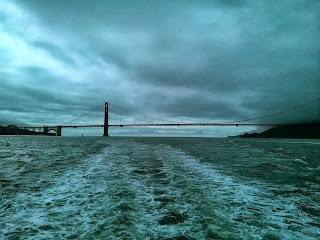San Francisco is the city of misty ocean bay sites,
fishing boats, art, and technology. From sour dough bread to dark chocolate, it
has a history of survival. Walking along the pier it is easy to see the charm,
as trolley’s flow through streets and lively patio dining are commonplace. Like
Paris, it affords a unique opportunity to watch the multitudes of people from
all of the world come to experience the tours, eat their fill, and enjoy the nightlife.
Walking up the shop lined streets you may even find a local art vendor willing
to part with their masterpiece for a few dollars. Its history is as
international as its people.
Sir Francis Drake first saw the bay in 1579 and took
note of it as he moved on to explore other opportunities. It stayed untouched
by European hands until the expedition by Gaspar de Portola who founded the
Presidio Army Base and a Catholic Church in the area around 1776. The goal was
to enslave and convert the local Ohlone population and set up a Spanish outpost.
The area moved into Mexican hands after
their independence and then to the U.S. in 1848 after the Mexican-American War.
The Presidio Army Base continued as a military
outlet until 1989 when the military reductions turned it into a park that
eventually became self-sufficient. A total of 219 years of military service
with three nations were operating at that base in various forms and times. The
government set up a trust and it is now a national park with hundreds of
thousands of visitors annually.
 Under the Spanish, the base hosted a garrison of
only 33 men. In 1848, the U.S. made it a
headquarters for a number of military units ending with the 6th
Army. It was a jumping off point for the
invasion of the Philippines and was a key defense point during WWII. It hosted
medical staff during the civil war as well as the Potomac Army. It was America’s
longest running base dating back generations and throughout the history of the
area.
Under the Spanish, the base hosted a garrison of
only 33 men. In 1848, the U.S. made it a
headquarters for a number of military units ending with the 6th
Army. It was a jumping off point for the
invasion of the Philippines and was a key defense point during WWII. It hosted
medical staff during the civil war as well as the Potomac Army. It was America’s
longest running base dating back generations and throughout the history of the
area. During the Gold Rush of 1848, San Francisco’s
population exploded from around 1,000 people to 25,000 people. The growth was
so large that the infrastructure could not keep up which is why the small
streets are still the norm continuing to cause traffic problems today. It
maintained for over a century a very large Chinese population that sought to seek
their fortunes and is of the largest populations outside of China totaling nearly
1/5th the city’s population.
During the Gold Rush of 1848, San Francisco’s
population exploded from around 1,000 people to 25,000 people. The growth was
so large that the infrastructure could not keep up which is why the small
streets are still the norm continuing to cause traffic problems today. It
maintained for over a century a very large Chinese population that sought to seek
their fortunes and is of the largest populations outside of China totaling nearly
1/5th the city’s population.
During the mad population explosion committees of vigilance
where created to deal with crime and corruption. They arrested, and sometimes killed
criminals, as well as forced a number of local politicians to resign. It was an
era where rapid explosion and wealth created corruption and damaged the lives
of its citizens. The people took the law into their own hands.
Somewhere around the 1890’s the city became known as
the Paris of the West. It was home to famous artists like the author Mark Twain
and an international community of creative thinkers. Streetcars were built and
the nightlife was at the top of its game. It was a place where people frequented
to create and invent while enjoying socializing with others from diverse
backgrounds.
Today, San Francisco is the 12th largest
U.S. city. It has a technology hub that has helped gentrify poor neighborhoods.
Likewise, rent is still considered high and people live a life that would be
uncommon for those in the rust belt. Yet despite these drawbacks it is still a
city where travelers from the entire world come to see the sites, where
companies bud, and where people freely express themselves. It is unique in its
cultural and social atmospheres.




